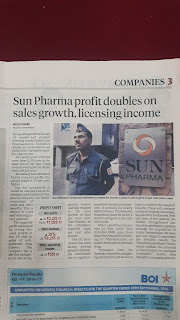2017: Pharma
marketing @ patient engagement
‘PwC’s Health Research
Institute (HRI) found in 2016 that the majority of consumers with chronic
conditions are willing to share their health data with pharma companies,
including how well treatments are working and information about daily symptoms’.
Ref.:
http://www.fiercepharma.com/marketing/pwc-posts-pharma-and-healthcare-industry-predictions-for-2017
Everyone is reading the tea leaves! Demonetization in India, has shaken up the
cash based economy, digital initiatives are making a lot of waves in buy-sell
transactions. The economy has doubled
its digital drive and e-commerce activities.
And yes, digital is the way forward, say the tea leaves!
With digital connect proving a method to
engage directly with patients of chronic lifestyle diseases, there is a big
time opportunity here for:
a) Vendors
who can create digital material and engagement strategies with patients
directly on behalf of pharmaceutical marketers
b) Retailers
(pharmacies) can create a digital method to engage with patients and get pharma
companies to partner them
c) Doctors
can create digital methods of interacting with patients beyond their clinics and
thus strengthen their patient connect
d) Pharmaceutical
companies can also launch direct patient connect initiatives to reiterate
brands and their usage
The era of digital marketing is here for
savvy pharma marketing professionals who are seeing and experiencing the
digital trend daily thanks to the Govt. which is also exhorting the go –
digital campaign. The governmental initiatives are creating a whole new class of digital savvy consumers and significant new
numbers of people are getting digital literate.
Mobile based access is the main way in
which digitisation is occurring in India today.
The mobile based digital method can be employed to create patient
connect programs.
There are two major ways of influencing
the sale of medicines and nutritionals:
a) The
primary method, is the medical
representative based approach, where each MR calls on atleast 10 doctors/day, who
influence the consumption of medicines and nutritionals
b) The
secondary method but most equally
important that engage with doctors and patients without MRs:
-
digital
based messaging
-
courier
(mailer) marketing, and
-
advertisements
in medical and nutritional based journals.
In
this regard it is interesting to recall the very market savvy and patient
friendly approach launched by IAP (Indian Academy of Pediatrics), which has
launched an educational TV network for patient-waiting rooms in pediatric
clinics and hospitals across the country (brand advertising is permitted in
their network, based on their selection of brands). This is a fantastic avenue to connect brands
with patients in the patient waiting room of pediatric centers.
There is humongous scope for digital
based marketing approach, which various market operators can cue onto.
Imaginary (hypothetical) example: Imagine a
retailer sells a hypothetical brand of company P: Green
Morning green tea. While raising the
invoice, the pharmacist feeds the consumer’s mobile number that has whatsapp
installed in it (the number is fed after obtaining the consumer’s
permission).
The software then takes over. Through whatsapp, the back end software sends
a small post.
‘Hi! Welcome to a clean, green and healthy
morning! Your great day starts with Green Morning, boil water with a bag of
Green Morning goodness dipped in
it. The polyphenol EGCG enters the water
from the tea bag to offer an amazingly high antioxidant power to quench the
toxic chemicals called: free radicals, in your body. Happy healthy mornings are Green Morning dips of healthy joy’. Buy your next pack of Company P: Green Morning tea bags from Balaji Medicals!!
Imagine such cyber-engagements, reinforcing
messages, sharing consumer experiences etc., through such messaging.
There can be many such digital
approaches, directly or indirectly engaging with patients and healthcare
consumers, and thus produce positive healthy outcomes through influential educational
messages.
The digital age in pharmaceutical
marketing is all set to roll as an unstoppable juggernaut in India. The penetration of healthcare messages and
brand messages of pharmaceutical and nutritional products will thus be on a large
canvas. A new age of pharma marketing is
born, say the tea leaves, … thanks to demonetization and digital social trend.
Thanks
for reading this blogpost, please scroll down and read all other posts (click
on older posts link as and when required), recommend this blog to your
acquaintances.
In the above
graphic Venn diagram, the universe is Pharma Product Promotion, the major sets
are Medical Representative (MR) based product promotion and Non – Medical Respresentative
(MR) based product promotion.
The main activities in the MR set are
in-clinic activities and in-pharmacy activities. The main activities in the non-MR set are
courier activity (mailer promotion), advertisements in medical journals and
digital marketing in websites, through mobile aps, whatsapp, email, banner
advertisements etc.
At the intersection of these two main
sets we have activities that may be carried out by MRs, or by outsourced
agencies (non-MR route) (this can be done by digital format also) – and these activities are: CMEs, stall or booth
activity and campaigns.







